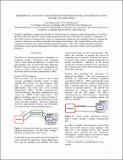| dc.description.abstract | Technical capabilities for improved surveillance over the oceans are currently available through the use of satellites.
However, all aircraft operators will not equip simultaneously because of the high costs required. Consequently, as
these CNS systems are integrated into oceanic air transportation architecture, the controller will have to manage the
current low frequency surveillance in parallel with enhanced surveillance. The cognitive effects of the mixed
equipage environment were studied through experimental analysis. The results confirm that there are human
performance issues with integrating mixed surveillance capabilities, which may result in safety and efficiency
limitations. | en |
